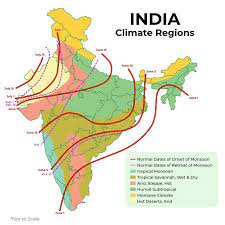India is a country known for its diverse climate and weather patterns. However Indian can be said to have Monsoon Type of Climate. The climate in India can be broadly categorized into six main climatic regions: the Himalayan region, the arid desert region, the tropical rainforest region, the semi-arid region, the coastal region, and the mountain region.

The Himalayan region is characterized by cold temperatures and heavy snowfall during the winter months, with moderate temperatures and rainfall during the summer months. The arid desert region, located in the northwest, experiences hot and dry weather throughout the year with very little rainfall.
The tropical rainforest region, located along the western coast and northeastern states, experiences heavy rainfall throughout the year and high humidity levels. The semi-arid region, located in central and southern India, has a hot and dry climate during the summer months and moderate rainfall during the monsoon season.
The coastal region, located along the eastern and western coasts of India, has a hot and humid climate with moderate rainfall throughout the year. The mountain region, located in the northern and northeastern states, experiences cold temperatures and heavy snowfall during the winter months, with moderate temperatures and rainfall during the summer months.
The monsoon season in India is a crucial aspect of the country’s climate, with the southwest monsoon bringing rainfall to most parts of the country from June to September. The northeast monsoon brings rainfall to the southeastern states from October to December.
India’s climate is also influenced by factors such as latitude, altitude, topography, and ocean currents. The country’s proximity to the equator, the presence of the Himalayas, and the Indian Ocean Dipole phenomenon are all contributing factors to India’s diverse climate patterns.
In recent years, climate change has also had a significant impact on India’s weather patterns, with increased frequency and intensity of extreme weather events such as droughts, floods, and heatwaves.
In conclusion, the climate of India is diverse and influenced by various factors. The country’s geography, including its location, topography, and proximity to the ocean and the Himalayas, contributes to the unique weather patterns across different regions. The monsoon season is a crucial aspect of India’s climate, with the southwest monsoon bringing vital rainfall to the country. However, climate change is posing significant challenges to India’s climate patterns and requires urgent attention and action to mitigate its effects.
Important Links